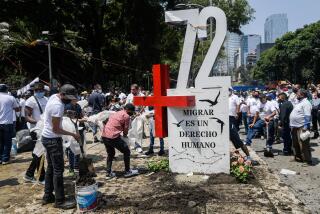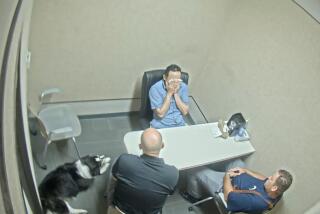Secrets died with slain Argentine
BUENOS AIRES — Hector Febres was the man who knew too much.
And, like a character in a spy novel damned with an excess of secrets, Febres met an untimely and grisly end: He was poisoned last month in his cell.
That is the conclusion of Argentine officials investigating the death of the former coast guard officer, who was awaiting a verdict on charges of torture. The case arose from Febres’ service under a military dictatorship decades earlier at the country’s most notorious clandestine detention center.
In the early hours of Dec. 10, authorities say, someone slipped Febres, 66, a lethal dose of cyanide, possibly in a glass of water. He had lived a comfortable, if confined, existence in an ample suite at a coast guard base for much of the last nine years as the case against him proceeded, glacier-like.
Judge Sandra Arroyo Salgado, who is overseeing the investigation, rejected speculation about suicide and ruled this month that Febres probably was slain to keep him silent. Who killed him remains a mystery.
As his long-delayed trial on charges of torturing four prisoners neared a verdict, authorities say, Febres felt betrayed by his former military colleagues. He may have been on the verge of coughing up some sensational secrets from the regime’s “dirty war” against what it called communist sympathizers.
Among the most anticipated potential revelations: the fate of newborn babies stolen from prisoners. The mothers were killed in one of the more macabre legacies of the 1976-83 military rule.
“Febres took all those cases to the tomb with him,” lamented Liliana Mazea, a human rights attorney.
The episode has again raised the specter of a shadowy network of assassins loyal to the former dictatorship. A witness in a separate case has been missing for more than a year.
Judge Arroyo Salgado this month ordered the arrest of two of Febres’ jailers, who were accused of providing access to the killer, or killers. One, Angel Volpi, was a close confidant of Febres.
And, in a bizarre twist, prosecutors charged Febres’ widow and his two children with helping to cover up the crime. The three deny any wrongdoing and were released after three weeks in custody.
The role that the family is suspected of playing remains unclear. The three still stand accused of tampering with items at the crime scene, including Febres’ computer, which was removed from his cell. Authorities suspect that data was erased or stolen.
Febres’ family dined with him at his cell the night before his death, according to reports here, sharing salads and grilled meat ordered from his favorite restaurant. Febres had even decorated a Christmas tree.
The prisoner was poisoned soon after, Arroyo Salgado wrote, to “prevent Febres from betraying his pact of silence for the crimes committed in the ESMA.”
That is the Spanish acronym for the Navy Mechanics School, the stately, white-colonnaded building on a main drag here that served as a concentration camp where thousands of prisoners were tortured and “disappeared.” Some were drugged and dumped into the ocean from aircraft; others were executed and buried anonymously. The former detention center is now a memorial museum.
Febres was not one of the dirty war big names in the gray rogues’ gallery of aging former generals, colonels and police chiefs awaiting trial. He was a military cop who became a key administrator, a brutal paper pusher who, literally, knew where all the bodies were. One of his nicknames: “Savage,” for his vicious comportment.
Accounts from survivors of the naval lockup indicate that Febres may have overseen the meticulous records that documented prisoners’ comings and goings. One former detainee, Carlos Lordkipanidse, testified that he saw rows of microfilms with “faces of boys and girls, older people, kids, older women, one after another.”
Those records, which could provide clues to the fates of legions of disappeared, have not been found.
Moreover, Febres is said to have overseen a particular subset of prisoners: pregnant women, methodically killed once they gave birth. Human rights activists say that as many as 500 babies may have been stolen at clandestine sites nationwide and placed in “good” families, many with ties to the military and police.
Testimony indicated that Febres would even buy clothing for the newborns, assuring the distraught mothers that the babies would be turned over to relatives. It was all a lie.
Was Febres, facing life behind bars far from the cushy digs at the coast guard base, poised to reveal details of the baby-snatching and other crimes? Did he have crucial details and records on his computer? Those are major unanswered questions.
“I think he did mean to use it [his information] as a form of negotiating something,” Victoria Donda, an Argentine lawmaker, told the daily Clarin newspaper.
Donda was among those born at the infamous naval facility, in 1977. Her parents were disappeared. She discovered her true identity years later. It was Febres, she says, who probably made the arrangements.
“I don’t know if I’ll ever know the name of the person who pushed my mother out of a plane,” Donda said, “but at least I’d like to see justice for the one who took me from her arms.”
--
Andres D’Alessandro of The Times’ Buenos Aires Bureau contributed to this report.
More to Read
Sign up for Essential California
The most important California stories and recommendations in your inbox every morning.
You may occasionally receive promotional content from the Los Angeles Times.










